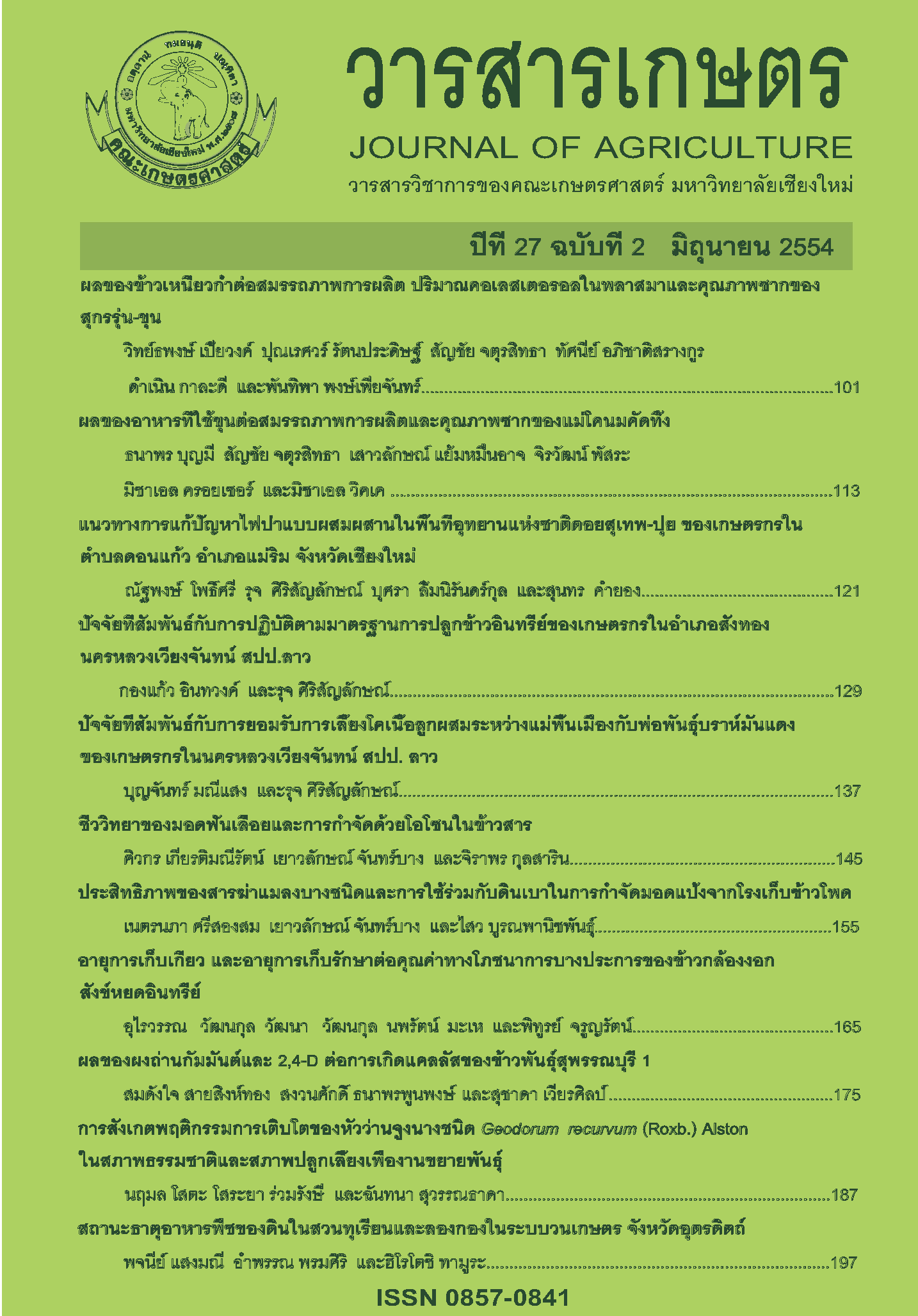ผลของข้าวเหนียวก่ำต่อสมรรถภาพการผลิตปริมาณคอเลสเตอรอลในพลาสมาและคุณภาพซากของสุกรรุ่น-ขุน
Main Article Content
บทคัดย่อ
ใช้สุกรลูกผสม 3 สายพันธุ์ (ลาร์จไวท์×แลนด์เรซ×ดูร็อค) จำนวน 30 ตัว น้ำหนักเฉลี่ย 30 กิโลกรัม แบ่งเป็น 3 กลุ่มการทดลอง กลุ่มละ 10 ตัว วางแผนการทดลองแบบสุ่มตลอด (completely randomized design, CRD) ให้สุกรได้รับอาหารที่มีแหล่งพลังงานต่างกันอย่างเต็มที่ คือ กลุ่มที่ 1 หรือกลุ่มควบคุม ได้รับอาหารพื้นฐาน โดยมีข้าวโพดและมันเส้นเป็นหลัก กลุ่มที่ 2 และ 3 ได้รับปลายข้าวขาวและปลายข้าวเหนียวก่ำเป็นแหล่งพลังงาน ตามลำดับ ทำการเลี้ยงจนถึงน้ำหนักตัว 100 กิโลกรัม พบว่า สุกรกลุ่มที่ 3 มีแนวโน้มกินอาหารได้มากกว่าและมีอัตราการเจริญเติบโตดีกว่าอีก 2 กลุ่ม แต่ความแตกต่างไม่มีนัยสำคัญ (P>0.05) ผลการวิเคราะห์พลาสมาในเลือดของสุกร พบว่า เมื่อสุกรมีอายุเพิ่มขึ้นจะมีปริมาณ คอเลสเตอรอล ไตรกลีเซอไรด์ HDL และ VLDL สูงขึ้น ส่วนการเปรียบเทียบระหว่างกลุ่มการทดลอง เมื่อสุกรมีน้ำหนักตัว 79 กิโลกรัม ปริมาณคอเลสเตอรอลและ LDL ในกลุ่มที่ 3 มีค่าต่ำกว่าอีก 2 กลุ่ม อย่างมีนัยสำคัญ (P<0.005 และ P<0.03) ด้านคุณภาพซาก พบว่า สุกรกลุ่มที่ 3 มีแนวโน้มของน้ำหนักที่เข้าฆ่าสูงกว่ากลุ่มที่ 1 และมีแนวโน้มน้ำหนักซากอุ่นดีกว่าอีก 2 กลุ่ม (P>0.05) การตัดแต่งซากแบบไทยพบว่าไม่มีความแตกต่างกัน (P>0.05) ส่วนคุณภาพซากที่ตัดแต่งแบบสากล พบว่า สุกรกลุ่มที่ 3 มีเปอร์เซ็นต์เนื้อสันนอกสูงกว่ากลุ่มที่ 2 อย่างมีนัยสำคัญ (P<0.05) ในขณะที่กลุ่มที่ 2 มีเปอร์เซ็นต์ซี่โครงสูงที่สุด (P<0.05)
Article Details
เอกสารอ้างอิง
ดิลก สิงหันต์. 2536. ความสัมพันธ์ของโปรตีนและระดับพลังงานต่อสมรรถนะและคุณภาพซากของสุกร รุ่น-ขุน. วิทยานิพนธ์วิทยาศาสตรมหาบัณฑิต มหาวิทยาลัยขอนแก่น. 92 หน้า.
ศูนย์วิจัยข้าวสุรินทร์. 2552. ข้าวก่ำอาหารเพื่อสุขภาพและยารักษาโรค [ระบบออนไลน์]. แหล่งที่มา: http://srn.ricethailand.go.th/srrc/fmsev/cont/kg.html (26 เมษายน 2552).
สัญชัย จตุรสิทธา. 2551. เทคโนโลยีเนื้อสัตว์. พิมพ์ครั้งที่ 2. ธนบรรณการพิมพ์, เชียงใหม่, 244 หน้า.
Behall, K. M., D. J. Scholfield and J. Hallfrisch. 2004. Diets containing barley significantly reduce lipids in mildy hypercholesterolemic men and women. Am. J. Clin. Nutr. 80: 1185-1193.
Bell, J. M. and M. O. Keith. 1993. Effects of combinations of wheat, corn or hulless barley with hulled barley supplemented with soybean meal or canola meal on growth rate, efficiency of feed utilization and carcass quality of market pigs. Anim. Feed. Sci. Tech. 44: 129-150.
Biggs, H. G., J. M. Erikson and W. R. Moorehead. 1975. Annual colorimetric assay of triglycerides in serum. Clin. Chem. 21: 437-441.
Camp, L. K., L. L. Southern and T. D. Bidner. 2003. Effect of carbohydrate source on growth performance, carcass traits, and meat quality of growing-finishing pigs. J. Anim. Sci. 81: 2488-2495.
Carr, S. N., P. J. Rincker, J. Killefer, D. H. Baker, M. Ellis and F. K. McKeith. 2005. Effects of different cereal grains and ractopamine hydrochloride on performance, carcass characteristics, and fat quality in late-finishing pigs. J. Anim. Sci. 83: 223-230.
Dejian H., B. Ou, M. Hampsch-Woodill, J. A. Flanagan and E. K. Deemer. 2002. Development of oxygen radical absorbance capacity assay for lipophilic antioxidants using randomly methylation of the solubility enhancer. J. Agri. Chem. 50: 1815-1821.
Fernandez, M. L., M. Vergara-Jimenez, K. Conde, T. Behr and G. Abdel-Fattah. 1997. Regulation of apolipoprotein B-containing lipoprotein by dietary soluble fiber in guinea pigs. Am. J. Clin. Nutr. 65: 814-822.
Finne-Nielsen, I. L., S. E. Rasmussen, A. Mortensen, G. Ravn-Haren, H. P. Ma, P. Knuthsen, B. F. Hansen, D. Mcphail, R. Freese, V. Breinholt, H. Frandsen and L. Dragsted. 2005. Anthocyanins increase low-density lipoprotein and plasma cholesterol and do not reduce atherosclerosis in Watanabe heritable hyperlipidemic rabbits. Mol. Nurt. Food. Res. 49: 301-308.
Hou, D. X. , T. Ose, S. Lin, K. Harazoro, I. Imamura, M. Kubo, T. Uto, N. Terahara, M. Yoshimoto and M. Fuji. 2003. Anthocyanidins induce apoptosis in human promyelocytic leukemia cell: Structure-activity relationship and mechanisms involved. Int. J. Oncol. 23: 705-712.
Jung, D. H., H. G. Biggs and W. R. Moorehead. 1975. Colorimetry of serum cholesterol with use of ferric acetate/uranyl acetate and ferrous sulfate/sulfuric acid reagent. Clin. Chem. 21: 1526-1540.
Kitpanit, N. 1981. The utilization of Thai cassava root products in swine ration. Thesis, Master of Science. Tokyo University of Agriculture, Japan.
Konczak-Islam, I., M. Yoshimoto, D. X. Hou, N. Terahara and O. Yamakawa 2003. Potential chemopreventive properties of anthocyanin-rich aqueous extract from grape seeds. J. Agri. Food Chem. 47: 1892-1897.
Kong, J. M., L. S. Chai, N. K. Goh, T. F. Chai and R. Brouillard. 2003. Analysis and biological activities of anthocyanins. Phytochem. 64: 923-933.
Lichenstein, A. H., L. M. Ausman, J. L. Jenner, W. Carrasco, L. J. Gualtieri, J. L. Jenner, J. M. Ordovas, R. J. Nicolosi, B. R. Goldin and E. J. Schaefer. 1994. Rice bran oil consumption and plasma lipid levels in moderaterly hypercholesterolemic humans. Arteriosclerosis 14(4): 549-556.
Mekki, N. , C. Dubois, M. Charbonier, L. Cara, M. Senft, A.M. Pauli, H. Portugal, A.M. Lafon and D. Lairon. 1997. Effect of lowering fat increasing dietary fiber on fasting and postprandial plasma lipids in hypercholesterolemic subjects consuming a mixed Mediterranean-Western diet. Am. J. Clin. Nutr. 66: 1443-1451.
Nakamura, H. 1996. Effect of γ-oryzanol on hepatic cholesterol biosynthesis and fecal excretion metabolites. Radioisotopes. 25:371-374.
Nakayama, S., A. Manabe, J. Suzuki, K. Sakamoto and T. Inagake. 1987. Comparative effects of two forms of γ-oryzanol in different sterol compositions on hyperlipidemia induced by cholesterol diet in rats. Jp. J. Pharmacol. 44(2): 135-143.
Ramsey, C. B., L. F. Tribble, C. Wu and K. D. Lind. 1990. Effects of grains, marbling and sex on pork tenderness and composition. J. Anim. Sci. 68: 148-154.
SAS. 2001. SAS User's Guide. Statistics. SAS. Inst. Inc., Cary, NC. USA.
Shinomiya, M., N. Morisaki, N. Matsuoka, Y. Zumi, A. Saito and A. Kumagai. 1983. Effect of gamma-oryzanol on lipid metabolism in rats fed high-cholesterol diet. Tohoku. J. Exp Med. 141: 191-197.
Vasupen, K., C. Yuangklang, S. Wongsuthavas, P. Srenanul, J. Mitchaothai and A. C. Beynen. 2008. Effect of dietary broken rice and on cassava chips growth, nutrient digestibility and nitrogen retention in growing kadon pigs. J. Food Technol. 6(2): 92-97.
Wilson, T. A., R. J. Nicolosi, B. Woolfrey and D. Kritchevsky. 2007. Rice bran oil and oryzanol reduce plasma lipid and lipoprotein cholesterol concentration and aortic cholesterol ester accumulation to a greater extent than ferulic acid hypercholesterolemic hamsters. J. Nutr. Biochem. 18: 105-112.
Wu, J. F., C. S. Cheng, I. T. Yu and J. N. Hsyu. 2000. Hulless barley as an alternative energy source for growing-finishing pigs on growth performance, carcass quality, and nutrient digestibility. Live Prod. Sci. 65: 155-160.
Zawistowski, J., A. Kopec and D. Kitts. 2009. Effect of a black rice extract (Oryza sativa, L. indica) on cholesterol levels and plasma lipid parameters in Wistar Kyoto rats. J. Funct. Food 1: 50-56.


